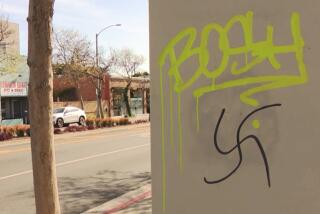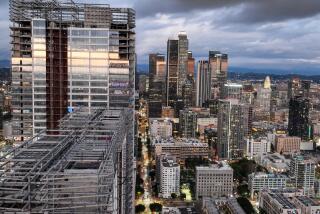Mural sparks outcry from residents of L.A.’s Eastside
Everyone’s an art critic when it comes to a $195,000 mural for the LAPD’s new Hollenbeck station.
The tile mural was meant to depict a quaint Sunday in Boyle Heights. Many angry residents say it makes their neighborhood out to be a crime-ridden dump filled with fat women, stray dogs, beer-swilling men and illegal street vendors. And don’t get them started about the piñata.
“There’s no American flag. There seems to be a rule against that,” said Rosalie Gurrola, born and raised in Boyle Heights, to rousing cheers and applause at a recent community meeting. “We need an American flag!”
The 4,000 tiles are glazed, fired and ready to be installed next month, but public outcry threatens to keep the artwork from ever going up.
The 100-foot mural by artist Sandow Birk has unwittingly tapped a raw nerve below the surface of a seemingly homogenous community, widely considered L.A.’s mothership of Mexican culture.
Residents complained about the unleashed dogs, about the “illegal” street vendors, about a man holding a can they guessed was beer. They complained about what wasn’t shown -- historical figures, children reading books, more war veterans, positive images of cops -- and about what was.
“This one lady has clothes drying on bushes,” said Vera Del Pozo, 56. “I’ve seen that in Mexico. Not here.”
Boyle Heights is 95% Latino, but the debate about the mural underscores the fact that it is far from homogenous about politics, culture and even its own self-image. It’s a neighborhood of roughly 90,000 people where new immigrants from Mexico live next to families who have been in L.A. for four generations. It was a key theater of the Chicano rights movement, has a large number of long-established gangs, but is also known for its conservative family values, a place one police officer called “a Mexican Mayberry.”
“It’s very contentious and dynamic in Boyle Heights,” said Robert Jimenez, a 37-year-old former Marine and president of the Boyle Heights Neighborhood Council. “There’s differences along linguistic lines and nationality. You have homeowner versus renter, English versus Spanish.”
Jaime Regalado, a Cal State L.A. political science professor who lived in Boyle Heights as a boy, said debate about the mural has shined a light on division usually kept below the surface. “If you’re taking about 90% of people having brown skin, then it’s a homogenous community,” he said. “But if you dig beneath the surface, there are differences about income and education. There are ideological differences. There are class differences.”
The Los Angeles Police Department isn’t thrilled about the mural either. In one scene, deep in the background of the mural, an officer stands behind a man next to a catering truck. The man’s hands are raised above his head.
“Maybe they’re asking him questions, and they’re going to let him go,” the artist said sheepishly.
But LAPD Capt. Blake Chow, commanding officer of the Hollenbeck station, isn’t buying it. “I think it really kind of paints a dark picture of Hollenbeck, and Boyle Heights in particular,” Chow said. “I got to tell you, I got assigned here last May . . . and this community has more pride than many other communities I’ve worked at.”
Roland Silva, an artist and member of the Boyle Heights Historical Society, said some residents were overreacting to certain images.
“Street vendors? Oh my goodness. That’s something that’s been around forever,” Silva, 57, said. “Might as well get the mariachis off the street.”
“And those street vendors wouldn’t be there if people weren’t buying,” Silva said.
Birk, 45, said he was stunned that he was even picked to do the large mural, mostly because he had expressed such a dim view of the LAPD -- both in his paintings and when he was interviewed by a city panel.
“I said the LAPD was one of the most dubious of the city branches,” Birk said during a recent interview. “I was quite honest about it. I was surprised that I was chosen.”
Birk based his idea for the mural on Diego Rivera’s work “Dream of a Sunday Afternoon in Alameda Park.” He included a skeletal character from that mural in the Boyle Heights mural; a woman selling items in her yard in Birk’s mural was based on a famous Rivera painting of an indigenous woman selling armfuls of flowers in the street.
Both women had tightly woven braids. But even that image has become controversial.
“I personally took offense that all the women are overweight -- and with braids,” said Teresa Marquez during the meeting, to laughter and applause. “I haven’t had braids since I was 5 years old!
Councilman Jose Huizar briefly attended the meeting, but left early for another event. His aides told the residents that “this mural is not something the councilman wants” and that its installation is “stalled.”
As he walked out, Huizar said he thought some images were stereotypical and said he objected to the scene of the man being stopped by an LAPD officer.
“It happens in our community, yes. But what we want is to give positive images about what this community is about,” he said.
But Huizar was surprised to hear some people were angry about the piñata in the mural.
“Really? How’s that?” he asked. “Nah? Really? This is, to me, a cultural thing.”
What about the man with the can in his hand?
“That could be anything,” Huizar said. “Then you’re reaching. You’re becoming too much of a critic.”
A woman pushing a cart that some said was an illegal street vendor?
“That is not a street vendor!” Huizar cried, looking at the image. “To me, that is a woman going shopping. Look at her, she’s got her bag.”
The saga over the mural began four years ago.
In October 2004, the Cultural Affairs agency and Birk showed the images of the proposed mural to the Boyle Heights Neighborhood Council, which had no veto power. The group had some criticisms and suggestions -- including having a woman at a garage sale selling Kobe Bryant T-shirts rather than Shaquille O’Neal shirts. Birk followed a few of their ideas -- like eliminating a scene of a man using a leaf blower. He replaced him with a man wearing a zoot suit.
Some of the debate over the mural is generational. Outside the community meeting, Juan Ortega, 17, and a girlfriend looked at pictures of the mural.
“People find this offensive?” asked Juan, a senior at Roosevelt High School. “Considering my age, I don’t find this offensive at all. But I mean, to older people, I guess it is.”
Postal worker Joe Gonzalez, 52, walked up to Ortega and begged to differ.
“See, that’s the heart of the problem. At your age, you don’t see this is offensive,” Gonzalez said. “At my age I see this as not inspiring for you at all. I think you deserve a hell of a lot better.”
More to Read
The biggest entertainment stories
Get our big stories about Hollywood, film, television, music, arts, culture and more right in your inbox as soon as they publish.
You may occasionally receive promotional content from the Los Angeles Times.







